ghazi52
PDF THINK TANK: ANALYST

- Joined
- Mar 21, 2007
- Messages
- 101,783
- Reaction score
- 106
- Country
- Location
,.,.,.
Muzhira Amin
August 26, 2023

The path is mostly clear, the terrain easy, and yet I keep losing my footing over stones hidden under the lush green grass because I just can’t seem to concentrate on the trail. My eyes refuse to break contact with the white mountains dominating the skies. For a moment, the delusion that I can touch the peaks overpowers, but the millennia-old glaciers, dazzling under the setting sun, are far too glorious for a mere cluster of blood and dust.
Astronomer Carl Sagan, in A Pale Blue Dot, puts my reverie perfectly into words. “On a scale of worlds,” he writes, “humans are inconsequential, a thin film of life on an obscure and solitary lump of rock and metal.”
To be on top of the second-highest plateau in the world, popularly known as the Deosai Plains, in the July summer was to feel almost unwanted. This was a place where humans are scarce, where silence hums and the fragrance of flowers, of every colour, fills the winds.

A map of the Deosai National Park prepared by locals.
A friend in Karachi, a wanderlust man of good taste, had spoken to me of Skardu — where the Deosai Plains are located — one evening. He told me of the intimidating Karakoram mountains, of small tea shops and of forts dating back centuries.
I desperately wanted to go. I was mourning the lush green mountains of Naran I had visited a few years back. But little did I know that the wonder of travel lies less in the reminiscence of lost time and more in the discovery of the new.
A week after the meeting with my friend, I met Amjad Maqpoon at a three-star hotel in Islamabad. It was a relief to see the lanky man with his wide-teeth smile and Balti accent, materialise out of a speculative WhatsApp group titled “Skardu-Deosai”. He was introduced to me by a local tour company, the ones that pop up on Instagram feeds every summer. We agreed on a price and decided to leave for Gilgit-Baltistan at 4am the next day.
The journey to the land of the mountains commenced with a flat tyre and an air-conditioning system that was best left untouched. But soon, we were zooming past the Hazara Motorway, out of the comfort of the capital’s sleek roads, towards a discreet rugged terrain, the mystery of which kept me up throughout the bumpy drive. I caught flashes of pine trees in deep shades of green framed against the deep blue sky and clear water of the Kunhar river.
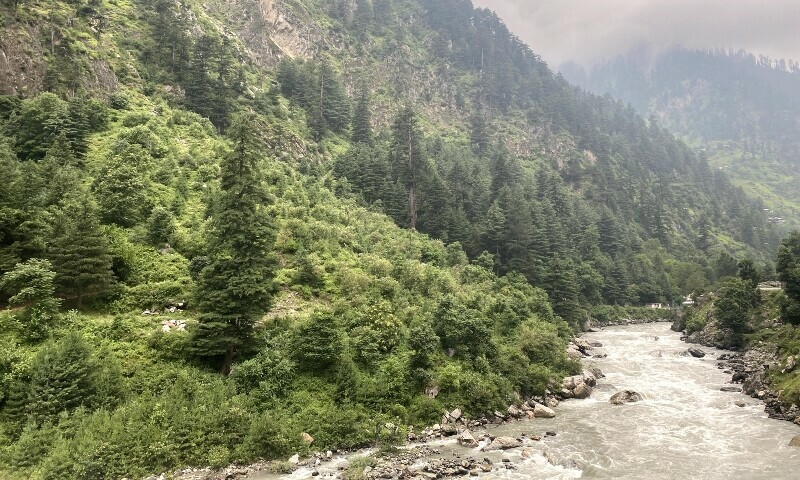
The lush green pine trees of Naran as the Kunhar river cascades its way down from the Lulusar Lake.
After a day on the road, we ascended into the mountains of GB through the Karakoram Highway (KKH), a road renowned for its sweeping vistas and sharp spiralling gradient.
The journey from Babusar Top to Chilas felt like a transition. The lush green mountains started losing their vegetation until they were completely replaced by daunting and jagged boulders that threatened to gulp you down. Sticking through thick and thin, the Indus river provided the perfect company to the towering peaks, crevicing through every stone, adamant not to leave the sunburnt Karakoram ranges alone.

The landscape gradually changes as you weave down to Chilas from the Babusar Top.
Novelist JM Coetzee once said: “There’s no mere landscape.” In GB I understood the real meaning of these words, for the landscape grew so diverse, but never lost the comfort of the mountains, showcasing the many facets of Earth.
After every few kilometres, eucalyptus trees appeared, serving both as a warning and greeting of the human population, in valleys sparsely covered with short and emerald grass. Ahead, in the same frame, were craggy mountains that led up to peaks of sunlit-snow. Sunburnt mountain rocks, with overgrown shrubs, played host to markhors. These impossible combinations, this infinite variety is what GB is. It is as if Earth is opening up its depths and revealing the complete range of all it has to offer.

The Indus river never leaves the side of the Karakoram Ranges.
Located in the lap of the Karakoram, downtown Skardu is a busy place, bustling with sun-tanned foreign mountaineers on the search for a souvenir to take back home. Locals, running tin-roofed small shops of antique items and dry fruits, are welcoming, almost always waiting for a chance to help a tourist.
“The crime rate in Skardu is zero,” Muhammad Iqbal, our driver, tells me. “And if you lose something here, the locals will make sure to find it and bring it safely back to you.”
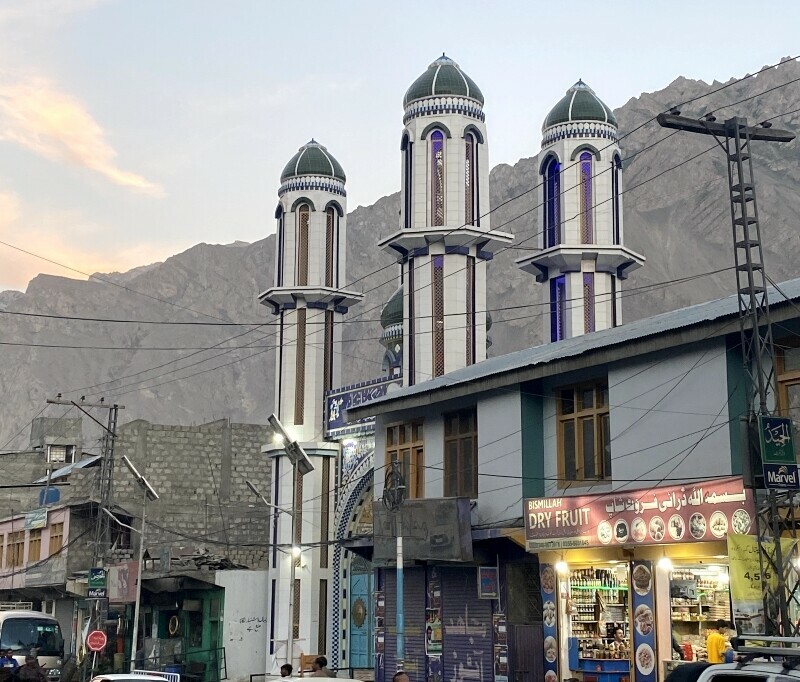
A glimpse of downtown Skardu.
A little past 9pm, after spending more than 12 hours on the road, we finally reached a small hotel called Apricot and Spring Resort. In the darkness of the night, the small lodges looked warm and comforting. But the next morning, under the beaming sunlight, I woke up to a small stream, veining through narrow and topless canals. Eucalyptus trees, with their white trunks, provided the perfect foreground to snow-capped peaks. The sight was a marvel. In front of it, I felt my body turn into a speck of dust, lost in the vastness of the world before me.
The thing about Skardu is that everywhere you see — twirl and you will get my point — the horizon is blanketed with white and brown peaks, smiling. It is almost inconceivable that the mountains could be this close to you.

A early morning view from the Apricot and Spring Resort in Skardu.
“Have you ever felt this exposed before?” Mohammad Hassan, a young man with golden-brown hair and a crooked smile, asked me. He was a local, assisting my tour guide with the trip. Hassan directed me to an old wooden gate at the far end of a walled garden crowded with apricot and apple trees. I opened it, and there in the crude frame, was the boundless expanse of rugged mountains with sharp rocks that looked as if they could fall on you any moment. It was arrestingly beautiful, and yet, I still felt an odd feeling that I didn’t belong here.
Hassan asked me multiple times if I wanted to capture the moment through an artificial lens. But I just couldn’t respond. It is strange. We say we travel for experiences, but when real experiences come our way, particularly those that can’t be easily put into words, we hesitate to record them. Perhaps because the lens can’t possibly do the memory justice.
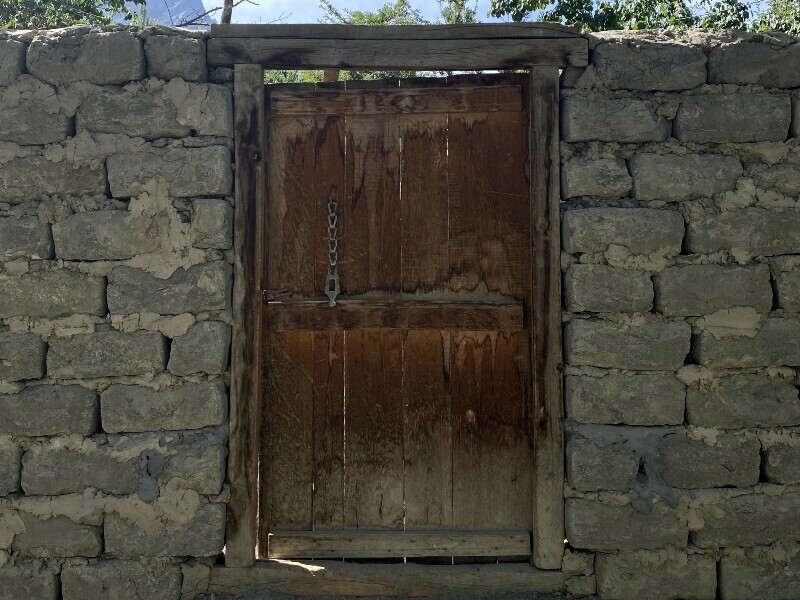
The door of my musings.
My musings were cut short by the call for breakfast. I ate narm roti and namkeen chai in a compact and mundane dining hall, adjacent to a small kitchen. Soon we were back on Skardu’s meandering roads, headed to a 17th century palace built on primordial rocks.
The entrance to Shigar Fort lies in a narrow alley, cocooned in the mountains. The palace, now turned into a museum and luxury hotel, was built by the Raja of the Amacha Dynasty. The intricate woodwork on the doors and windows of the palace narrate a story of their own — so do the intimate rooms where kings and queens once rested.

The ancient Shigar Fort stands in all its glory.
“The maharani would sit by the window,” our guide tells us, “waiting for her raja to come back from deadly wars.” As I sat on the edge of the window sill, a sense of longing, unknown to me, took over. It came in waves followed by a sudden sense of calm.
From the window, the world was a hazy sight of canopies surrounded by grey mountains. I felt I stood at the periphery of an interconnected world of disbelief and fantasy.
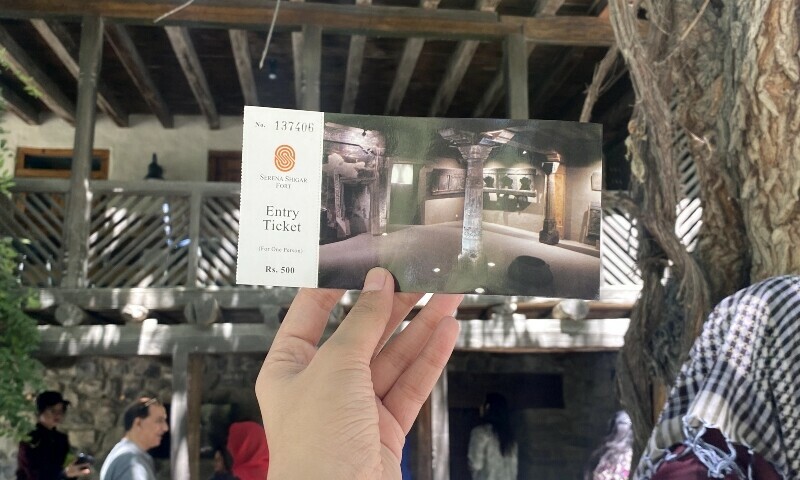
A snapshot of the entry pass to the Shigar Fort.
But the hidden glory of the desert unveiled itself as the sun set, its beams sparkling against the silver sand. As it grew dark, the sky was encrusted with thick clusters of stars. These tiny specks of light, I feel, have a secret love affair with the mountains. The two, teasing each other, deceive you with their proximity, when in reality, their reunion is an impossible tale.
With a hangover from the previous night’s star gazing, the next morning we headed for Kharmang, a district located at a 40-minute drive from Skardu.
“Kharmang is the district that connects Pakistan to India via Kargil,” Hassan told me during the choppy drive. During breakfast that morning, the boy from the mountains, as I like to call him, refused to tell me the secret place he was taking me to.
“Madam, I am taking you to the door to jannat [heaven] today,” he enthusiastically said. Hassan’s confidence started creating an image in my mind, of what could and could not be, but what my eyes witnessed at the Manthoka Waterfall was really, as the mountain boy said, a portal to another world.
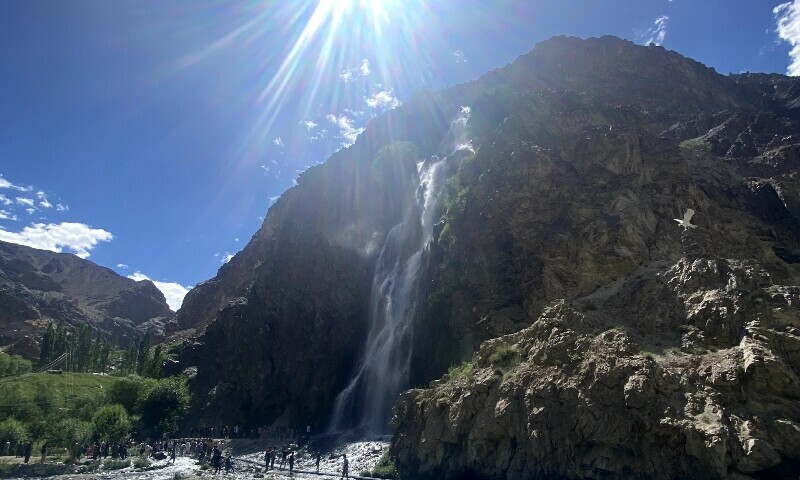
The Manthoka Waterfall in Kharmag district.
Summers in Skardu and other areas of Baltistan are humid. The air is hot and the sun shines too bright, both for the eyes and the body. But in the far north of the region, a natural air conditioner is at work as ice on massive glaciers melts into the rivers and ultimately merges into the mighty Indus.
I dipped my feet into the ice-cold water. It left me numb for the first few minutes but then evoked a spark.
The next moment, I found myself dipping my face into the magical stream. They say rivers have memories. After that dunk into the Mathoka Waterfall, I knew they were right. The water is a Pensieve of memories, an echo of lethal wars, a recollection of the people who lived and died, a never-ending journey of progression.
After sitting on the sharp rocks for what seemed like forever, I had the urge to move to the heart of the waterfall and see the organ that pumps pure bliss. I did eventually reach there, but after crossing a suspension bridge that added adventure to my fairly dreamy escapade.
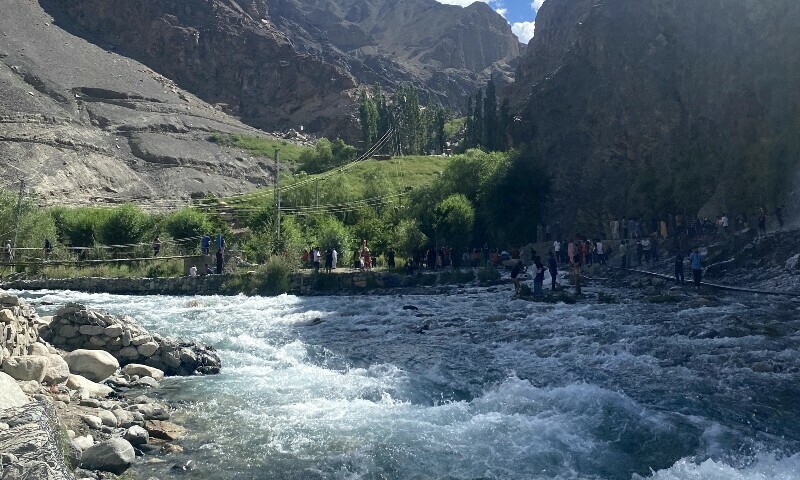
A suspension bridge of sorts needs to be crossed to reach the mouth of the waterfall.
Crossing the pul-e-sirat, what we jokingly called the bridge, I reached the mouth of the 180-foot tall waterfall. The freezing water droplets, as they condensed into the air, soothed my sunburns from the Sarfaranga Desert.
Mantokha was the most crowded among all the places I visited in Baltistan. It wasn’t a surprise to be honest — after all, humans can’t live without water. And here, it was in its purest form — wild, clear and untethered.
On my last morning in Skardu, I finally headed out for a day-long excursion to the Deosai Plains, the roof of the world where I left a piece of my heart.
The landscape is a dazzling contrast of viridescent grass, vibrant flowers, subdued streams, icy pinnacles and cotton clouds. It seemed to be straight out of a fictional tale — so abstract, so suggestive, so moving in its determination to remain as material proof of the world that once was.
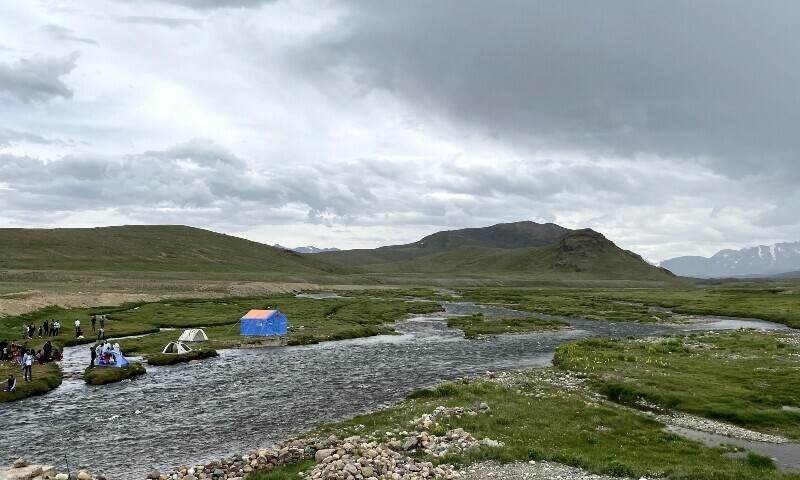
This isn’t a Microsoft wallpaper, it’s the Deosai Plains.
But little did I know that beyond the grassland lay an alpine lake, located in the heart of the Deosai Plains, amid the snowy peaks of the Himalayas and Kargil.
When we arrived at the Sheosar Lake after a three-hour hike, I was heaving. The reason was not just my out of shape body, but also the sight before me. In the middle of a vast arena sat a sombre but breathtaking pool of water, the source of which were stardust glaciers.
I was welcomed by light snowfall as I reached the lake. Within minutes of registering the view in front of me, I set out for more. We climbed a hill adjacent to the lake. As I sat on a rock, half dangling from the edge of a cliff, the silence of my surroundings engulfed me. I went still.

The silence at the Sheosar Lake is never a miss.
I had been in Skardu scarcely a few days, but for the first time in my 26 years of life, I felt as if I had entered a sphere of deep atavisms and belonging. It had been a surreal journey, in which I had let people, experiences and places come to be without resisting. And it was to take yet another turn.
As I entered the fourth day of my trip, sunburnt and filthy, with hardly any spare clothes left, Hassan surprised me with a small getaway to yet another waterbody — they just keep calling me — the Upper Kachura Lake.
This one was located in the centre of the rugged Karakoram, once again surrounded by eucalyptus trees.
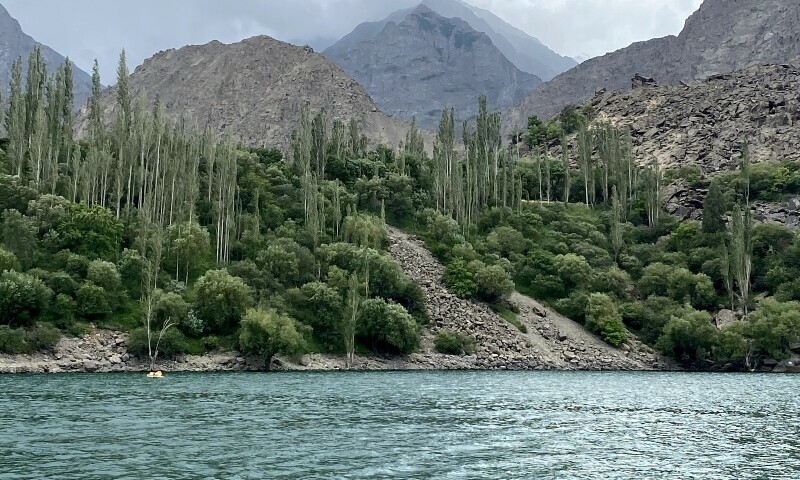
The beauty of the Upper Kachura Lake can’t be described in words.
“This lake is over 250 feet deep,” my mountain boy said. “In the secrets of the water lie hundreds of people, now dead, who were once pulled by the beauty of this place.”
Hearing this sent chills down my spine — not because my life was too dear to me, but because I might have been one of those people who succumbed to the enchanting water, without any regrets or resistance.
Soon, as we turned our backs to the Upper Kachura Lake, to gear up for the long journey back to Karachi, I would be left with an odd feeling of melancholy. Soon there would be a table of friends waiting for a wonderful dinner. Soon I would have to bid farewell to two strange tour guides who are too kind.
Soon there would be all this and more, but before I drove away from the mountains and ‘civilisation’ returned with all its force, I found it hard to let go of Skardu — beautiful and wild.
My friend in Karachi had mentioned the persistence of Gilgit-Baltistan’s magic. In Skardu, I knew I would be leaving this magic behind me, swerving through the KKH, back into the land of rules.
In all honesty, it was a feeling of emptiness, of being vacated by the mountains. The tranquility I had found quietly faded — the noise returned. But perhaps deep down, I knew they were with me. I could feel the glacial streams running through my veins. I had brought the pahaar back home with me.
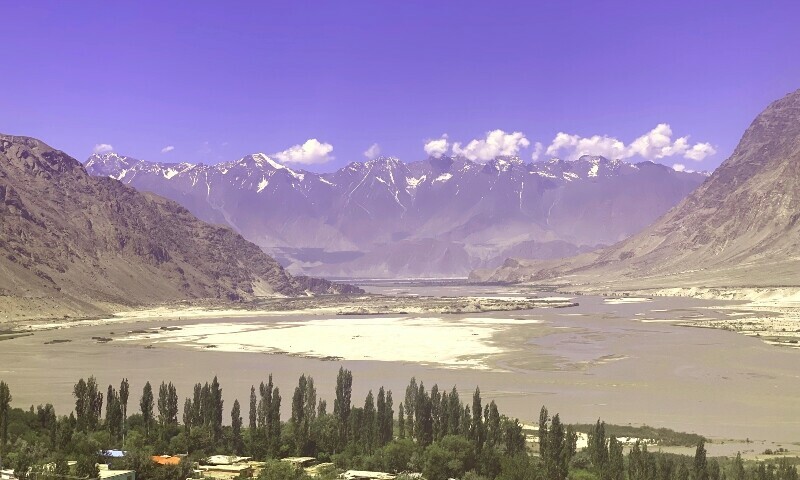
Lost and found in Skardu — where mountains meet the soul
They say rivers have memories. After that dunk into the Mathoka Waterfall, I knew they were right.Muzhira Amin
August 26, 2023
The path is mostly clear, the terrain easy, and yet I keep losing my footing over stones hidden under the lush green grass because I just can’t seem to concentrate on the trail. My eyes refuse to break contact with the white mountains dominating the skies. For a moment, the delusion that I can touch the peaks overpowers, but the millennia-old glaciers, dazzling under the setting sun, are far too glorious for a mere cluster of blood and dust.
Astronomer Carl Sagan, in A Pale Blue Dot, puts my reverie perfectly into words. “On a scale of worlds,” he writes, “humans are inconsequential, a thin film of life on an obscure and solitary lump of rock and metal.”
To be on top of the second-highest plateau in the world, popularly known as the Deosai Plains, in the July summer was to feel almost unwanted. This was a place where humans are scarce, where silence hums and the fragrance of flowers, of every colour, fills the winds.

A map of the Deosai National Park prepared by locals.
A journey along the Indus
One has to sit through a four-hour ride and traverse through a gnarled trail carved out of ancient rocks to reach the “roof of the world”, far beyond colonial boundaries and modern tensions, situated in the heart of the Western Himalayas at an elevation of 4,114 meters or 13,497 feet.A friend in Karachi, a wanderlust man of good taste, had spoken to me of Skardu — where the Deosai Plains are located — one evening. He told me of the intimidating Karakoram mountains, of small tea shops and of forts dating back centuries.
I desperately wanted to go. I was mourning the lush green mountains of Naran I had visited a few years back. But little did I know that the wonder of travel lies less in the reminiscence of lost time and more in the discovery of the new.
A week after the meeting with my friend, I met Amjad Maqpoon at a three-star hotel in Islamabad. It was a relief to see the lanky man with his wide-teeth smile and Balti accent, materialise out of a speculative WhatsApp group titled “Skardu-Deosai”. He was introduced to me by a local tour company, the ones that pop up on Instagram feeds every summer. We agreed on a price and decided to leave for Gilgit-Baltistan at 4am the next day.
The journey to the land of the mountains commenced with a flat tyre and an air-conditioning system that was best left untouched. But soon, we were zooming past the Hazara Motorway, out of the comfort of the capital’s sleek roads, towards a discreet rugged terrain, the mystery of which kept me up throughout the bumpy drive. I caught flashes of pine trees in deep shades of green framed against the deep blue sky and clear water of the Kunhar river.

The lush green pine trees of Naran as the Kunhar river cascades its way down from the Lulusar Lake.
After a day on the road, we ascended into the mountains of GB through the Karakoram Highway (KKH), a road renowned for its sweeping vistas and sharp spiralling gradient.
The journey from Babusar Top to Chilas felt like a transition. The lush green mountains started losing their vegetation until they were completely replaced by daunting and jagged boulders that threatened to gulp you down. Sticking through thick and thin, the Indus river provided the perfect company to the towering peaks, crevicing through every stone, adamant not to leave the sunburnt Karakoram ranges alone.

The landscape gradually changes as you weave down to Chilas from the Babusar Top.
Novelist JM Coetzee once said: “There’s no mere landscape.” In GB I understood the real meaning of these words, for the landscape grew so diverse, but never lost the comfort of the mountains, showcasing the many facets of Earth.
After every few kilometres, eucalyptus trees appeared, serving both as a warning and greeting of the human population, in valleys sparsely covered with short and emerald grass. Ahead, in the same frame, were craggy mountains that led up to peaks of sunlit-snow. Sunburnt mountain rocks, with overgrown shrubs, played host to markhors. These impossible combinations, this infinite variety is what GB is. It is as if Earth is opening up its depths and revealing the complete range of all it has to offer.

The Indus river never leaves the side of the Karakoram Ranges.
A land beyond my imagination
The sun had set, leaving behind a sky covered in hues of orange, when the KKH finally entered Skardu — also known as the mountaineer’s paradise — 1,423km from Karachi, where I had first set off from. The city, which connects the lifeline Indus to Pakistan, welcomed me with lights twinkling from tiny abodes on mountains.Located in the lap of the Karakoram, downtown Skardu is a busy place, bustling with sun-tanned foreign mountaineers on the search for a souvenir to take back home. Locals, running tin-roofed small shops of antique items and dry fruits, are welcoming, almost always waiting for a chance to help a tourist.
“The crime rate in Skardu is zero,” Muhammad Iqbal, our driver, tells me. “And if you lose something here, the locals will make sure to find it and bring it safely back to you.”

A glimpse of downtown Skardu.
A little past 9pm, after spending more than 12 hours on the road, we finally reached a small hotel called Apricot and Spring Resort. In the darkness of the night, the small lodges looked warm and comforting. But the next morning, under the beaming sunlight, I woke up to a small stream, veining through narrow and topless canals. Eucalyptus trees, with their white trunks, provided the perfect foreground to snow-capped peaks. The sight was a marvel. In front of it, I felt my body turn into a speck of dust, lost in the vastness of the world before me.
The thing about Skardu is that everywhere you see — twirl and you will get my point — the horizon is blanketed with white and brown peaks, smiling. It is almost inconceivable that the mountains could be this close to you.

A early morning view from the Apricot and Spring Resort in Skardu.
“Have you ever felt this exposed before?” Mohammad Hassan, a young man with golden-brown hair and a crooked smile, asked me. He was a local, assisting my tour guide with the trip. Hassan directed me to an old wooden gate at the far end of a walled garden crowded with apricot and apple trees. I opened it, and there in the crude frame, was the boundless expanse of rugged mountains with sharp rocks that looked as if they could fall on you any moment. It was arrestingly beautiful, and yet, I still felt an odd feeling that I didn’t belong here.
Hassan asked me multiple times if I wanted to capture the moment through an artificial lens. But I just couldn’t respond. It is strange. We say we travel for experiences, but when real experiences come our way, particularly those that can’t be easily put into words, we hesitate to record them. Perhaps because the lens can’t possibly do the memory justice.

The door of my musings.
My musings were cut short by the call for breakfast. I ate narm roti and namkeen chai in a compact and mundane dining hall, adjacent to a small kitchen. Soon we were back on Skardu’s meandering roads, headed to a 17th century palace built on primordial rocks.
The entrance to Shigar Fort lies in a narrow alley, cocooned in the mountains. The palace, now turned into a museum and luxury hotel, was built by the Raja of the Amacha Dynasty. The intricate woodwork on the doors and windows of the palace narrate a story of their own — so do the intimate rooms where kings and queens once rested.

The ancient Shigar Fort stands in all its glory.
“The maharani would sit by the window,” our guide tells us, “waiting for her raja to come back from deadly wars.” As I sat on the edge of the window sill, a sense of longing, unknown to me, took over. It came in waves followed by a sudden sense of calm.
From the window, the world was a hazy sight of canopies surrounded by grey mountains. I felt I stood at the periphery of an interconnected world of disbelief and fantasy.

A snapshot of the entry pass to the Shigar Fort.
‘A door to heaven’
That afternoon, we also stopped at the Sarfaranga Desert. At a height of 7,500 feet, its lines brought a feeling of continuity to me. The imperishable vastness was uninterrupted as the Karakoram ranges ran around it like a sea wall.But the hidden glory of the desert unveiled itself as the sun set, its beams sparkling against the silver sand. As it grew dark, the sky was encrusted with thick clusters of stars. These tiny specks of light, I feel, have a secret love affair with the mountains. The two, teasing each other, deceive you with their proximity, when in reality, their reunion is an impossible tale.
With a hangover from the previous night’s star gazing, the next morning we headed for Kharmang, a district located at a 40-minute drive from Skardu.
“Kharmang is the district that connects Pakistan to India via Kargil,” Hassan told me during the choppy drive. During breakfast that morning, the boy from the mountains, as I like to call him, refused to tell me the secret place he was taking me to.
“Madam, I am taking you to the door to jannat [heaven] today,” he enthusiastically said. Hassan’s confidence started creating an image in my mind, of what could and could not be, but what my eyes witnessed at the Manthoka Waterfall was really, as the mountain boy said, a portal to another world.

The Manthoka Waterfall in Kharmag district.
Summers in Skardu and other areas of Baltistan are humid. The air is hot and the sun shines too bright, both for the eyes and the body. But in the far north of the region, a natural air conditioner is at work as ice on massive glaciers melts into the rivers and ultimately merges into the mighty Indus.
I dipped my feet into the ice-cold water. It left me numb for the first few minutes but then evoked a spark.
The next moment, I found myself dipping my face into the magical stream. They say rivers have memories. After that dunk into the Mathoka Waterfall, I knew they were right. The water is a Pensieve of memories, an echo of lethal wars, a recollection of the people who lived and died, a never-ending journey of progression.
After sitting on the sharp rocks for what seemed like forever, I had the urge to move to the heart of the waterfall and see the organ that pumps pure bliss. I did eventually reach there, but after crossing a suspension bridge that added adventure to my fairly dreamy escapade.

A suspension bridge of sorts needs to be crossed to reach the mouth of the waterfall.
Crossing the pul-e-sirat, what we jokingly called the bridge, I reached the mouth of the 180-foot tall waterfall. The freezing water droplets, as they condensed into the air, soothed my sunburns from the Sarfaranga Desert.
Mantokha was the most crowded among all the places I visited in Baltistan. It wasn’t a surprise to be honest — after all, humans can’t live without water. And here, it was in its purest form — wild, clear and untethered.
On my last morning in Skardu, I finally headed out for a day-long excursion to the Deosai Plains, the roof of the world where I left a piece of my heart.
The landscape is a dazzling contrast of viridescent grass, vibrant flowers, subdued streams, icy pinnacles and cotton clouds. It seemed to be straight out of a fictional tale — so abstract, so suggestive, so moving in its determination to remain as material proof of the world that once was.

This isn’t a Microsoft wallpaper, it’s the Deosai Plains.
But little did I know that beyond the grassland lay an alpine lake, located in the heart of the Deosai Plains, amid the snowy peaks of the Himalayas and Kargil.
When we arrived at the Sheosar Lake after a three-hour hike, I was heaving. The reason was not just my out of shape body, but also the sight before me. In the middle of a vast arena sat a sombre but breathtaking pool of water, the source of which were stardust glaciers.
I was welcomed by light snowfall as I reached the lake. Within minutes of registering the view in front of me, I set out for more. We climbed a hill adjacent to the lake. As I sat on a rock, half dangling from the edge of a cliff, the silence of my surroundings engulfed me. I went still.

The silence at the Sheosar Lake is never a miss.
I had been in Skardu scarcely a few days, but for the first time in my 26 years of life, I felt as if I had entered a sphere of deep atavisms and belonging. It had been a surreal journey, in which I had let people, experiences and places come to be without resisting. And it was to take yet another turn.
As I entered the fourth day of my trip, sunburnt and filthy, with hardly any spare clothes left, Hassan surprised me with a small getaway to yet another waterbody — they just keep calling me — the Upper Kachura Lake.
This one was located in the centre of the rugged Karakoram, once again surrounded by eucalyptus trees.

The beauty of the Upper Kachura Lake can’t be described in words.
“This lake is over 250 feet deep,” my mountain boy said. “In the secrets of the water lie hundreds of people, now dead, who were once pulled by the beauty of this place.”
Hearing this sent chills down my spine — not because my life was too dear to me, but because I might have been one of those people who succumbed to the enchanting water, without any regrets or resistance.
Soon, as we turned our backs to the Upper Kachura Lake, to gear up for the long journey back to Karachi, I would be left with an odd feeling of melancholy. Soon there would be a table of friends waiting for a wonderful dinner. Soon I would have to bid farewell to two strange tour guides who are too kind.
Soon there would be all this and more, but before I drove away from the mountains and ‘civilisation’ returned with all its force, I found it hard to let go of Skardu — beautiful and wild.
My friend in Karachi had mentioned the persistence of Gilgit-Baltistan’s magic. In Skardu, I knew I would be leaving this magic behind me, swerving through the KKH, back into the land of rules.
In all honesty, it was a feeling of emptiness, of being vacated by the mountains. The tranquility I had found quietly faded — the noise returned. But perhaps deep down, I knew they were with me. I could feel the glacial streams running through my veins. I had brought the pahaar back home with me.

Lost and found in Skardu — where mountains meet the soul
They say rivers have memories. After that dunk into the Mathoka Waterfall, I knew they were right.
www.dawn.com
